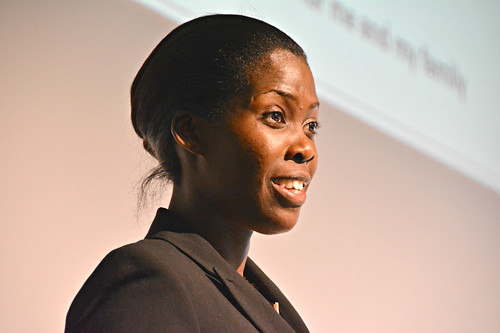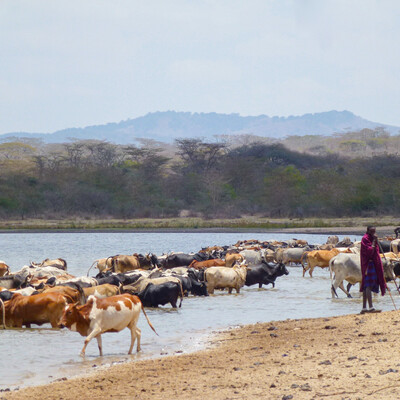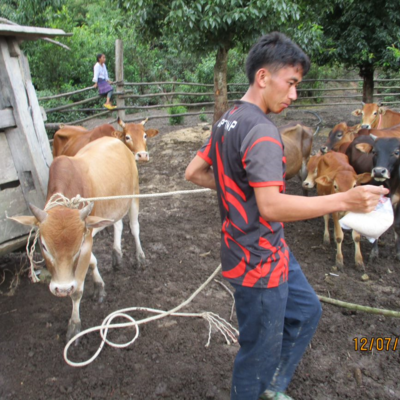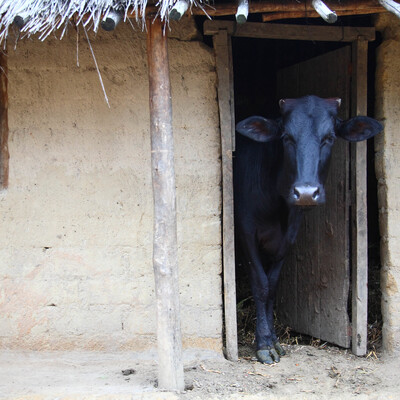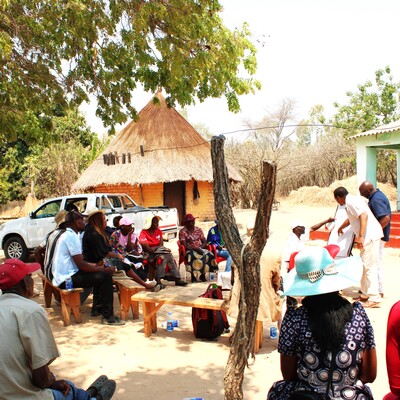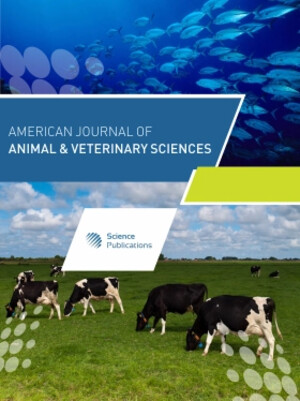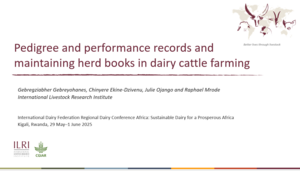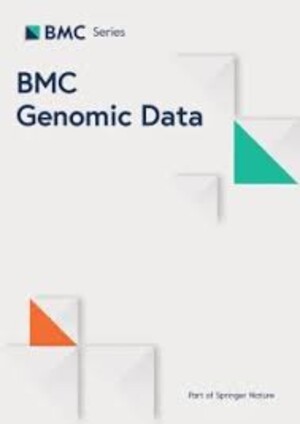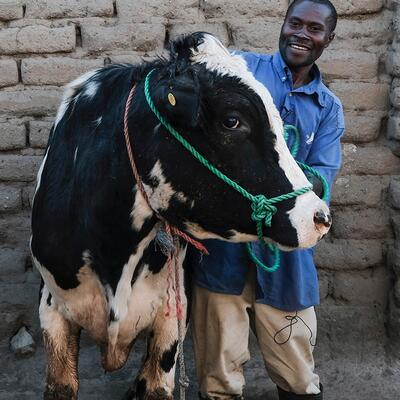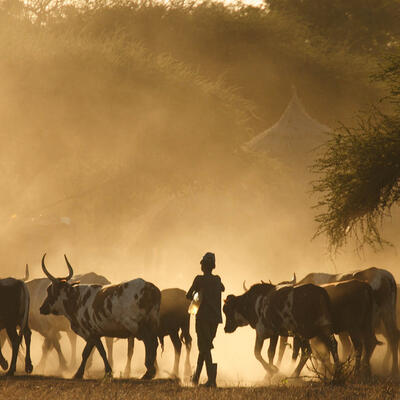
Ugandan Emma Naluyima describes her thriving pig+crop farm at the Global Forum for Food and Agriculture
Emma Naluyima, a Ugandan veterinarian and one-acre pig and crop farmer, making a presentation at the Global Forum for Food and Agriculture (GFFA) (photo credit: ILRI/Susan MacMillan).
On 19 Jan 2018, one of ten expert panel discussions at the Global Forum for Food and Agriculture (GFFA) was held on Sustainable solutions to the livestock sector: The time is ripe! This two-hour session was organized jointly by the German Federal Ministry for Economic Cooperation and Development (BMZ), the German Corporation for International Cooperation (GIZ), the International Livestock Research Institute (ILRI), the Global Agenda for Sustainable Livestock (GASL) and the Livestock Global Alliance (LGA).
This session was moderated by ILRI Assistant Director General Shirley Tarawali. Following a welcome by ILRI Director General Jimmy Smith, Stefan Schmitz, head of BMZ’s division of rural development and food security and commissioner for BMZ’s special initiative on One World–No Hunger, gave an opening speech. Fritz Schneider, chair of the Global Agenda for Sustainable Livestock (GASL), then gave a short overview of livestock and the UN’s Sustainable Development Goals, followed by a presentation by Kenyan Robin Mbae on livestock and climate change and a presentation by nutrition scientist Lora Iannotti on livestock and animal-source foods.
Shirley Tarawali then introduced the final speaker of this GFFA expert panel session. Emma Naluyima is a smallholder farmer and private veterinarian in Uganda who has integrated crop growing and livestock raising to build a thriving, profitable and environmentally friendly farm enterprise for her and her family.
‘I’m a smallholder farmer. It’s important that smallholder farmers integrate livestock into their farming. It’s feasible, productive and profitable. It’s made a difference to my life and family.
‘I did my master’s degree paying the tuition for my studies from the pigs that I reared. I’ve been able to take my children to very good schools. And I have a stable income. I own a car—a German car—made possible by livestock. And I was able to set up a school to continue passing on information to young children.
‘The founder of the Buganda kingdom, called Kintu, where I come from, kept livestock. Of all things in the world, he kept a cow. That cow enabled him to do integrated farming.
‘Today in Uganda and elsewhere, people use livestock not only for food and income, but also as a bank account and as insurance. They can sell their cattle to take their children to school. They can sell their cattle to get medical attention. And in the eastern part of the country, if you don’t have cattle you cannot marry a girl. So cattle, and livestock in general, are very, very important.

‘Here’s how it works for me and my family. My farm is called ‘One Acre Limited’. I divided it into quarters. On one quarter, I keep pigs. On another quarter, I keep cattle. On a third quarter, I grow matoke, or cooking banana. And on the other quarter, I grow fish, fodder for the animals and vegetables and fruits.

‘Pigs are my favourite animal. I feel cheated if I am not introduced as ‘Mama Pig’. That’s because I’m standing here today not because I’m a vet but because I’m a farmer—a pig farmer.

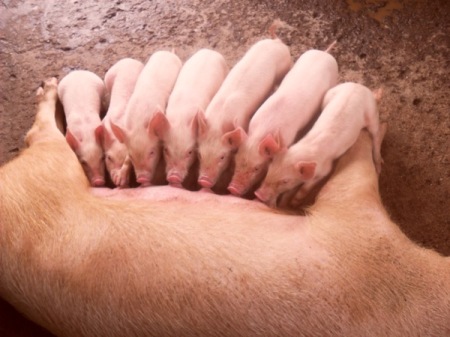
‘In this quarter where I grow pigs, I use the urine from the pigs as urea fertilizer. I use the pig dung to produce maggots that feed my fish and chickens, to grow earthworms and to produce biogas.
‘I do all this before I produce the pork. My pigs eat fodder that I grow on the farm.

‘This is the urine we collect from the pig house and take to the garden. The ammonia in this urine helps repel pests from my plants.
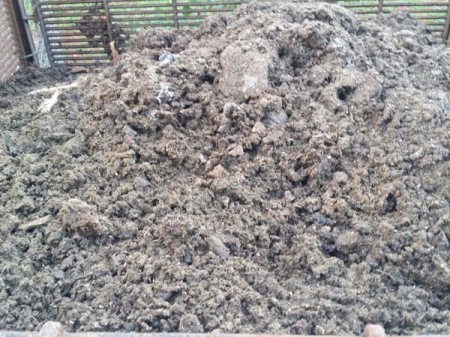
‘And this is pig dung, which is “green gold”. This is where my money comes from before I get pork. I would be grateful to any scientist who could make me diapers for pigs—because I don’t want to lose a speck of pig dung!

‘We collect the pig dung and use it to feed houseflies, which in turn produce larvae, or maggots, that we use to feed the fish and chickens. These maggots comprise 65% crude protein, which is higher than the protein content of our other animal feeds. My chickens grow faster when feeding on the maggots: in four weeks I can produce a chicken weighing 1.5 kilos rather than 1 kilo.

‘These are my lovely local chickens. In my local area, these might be thought to be one year old, but these birds are just 3–4 months old. I spend nothing to feed my chickens. It’s my pigs that are doing this. And then at the end of the day I get very nutritious, very yellow-yolked, eggs.

‘These are earthworms. After we’ve collected all the maggots from the pig dung, we introduce earthworms and then they feed on the pig dung and reproduce and create soil, which I sell and make money from as well. The earthworms excrete a liquid that I use as a fertilizer and as a pesticide that repels aphids and nematodes. And of course the fish feed on the earthworms.

‘In the second quarter of my one-acre farm, I keep five zero-grazed cattle (my target is 10–15 cows). Each cow gives me on average 20 litres of milk a day. I sell the milk and earn about USD3,000 a year. I use the cow dung to produce biogas and the slurry from the dung to fertilize my maize crop and to make silage. This is very profitable. I don’t have to spend money buying inorganic fertilizer.

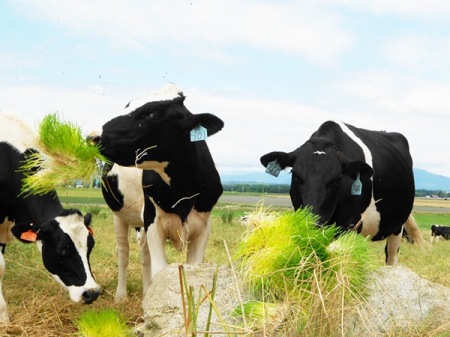
‘These are some of my cows. At the top is a Guernsey-Jersey cross eating hay, below are Holstein-Friesians eating hydroponic fodder.

‘And above is the anaerobic digester I use to produce biogas.

‘Back home, almost everyone has a charcoal stove or uses firewood for cooking. I don’t use either. I just use biogas. You can see how clean this saucepan is above (you can think it’s German!). When we use a charcoal stove or firewood, we are cutting down trees, So my livestock help me to reduce both deforestation and climate change.

‘The slurry that comes from the biogas I take back to the garden.
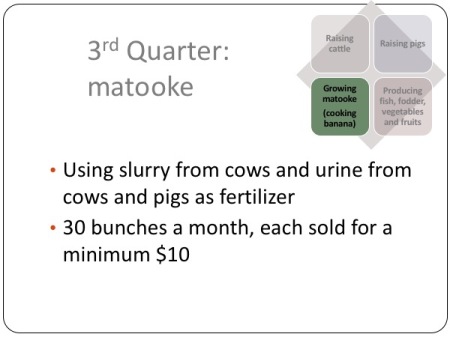
‘This slurry is what I use on my third quarter, the banana plantation, which gives us our staple food.

While the staple food of Germany may be sausages and pork, the staple food of my home is the cooking banana, called ‘matoke’, From this quarter of my farm I get about 30 bunches of banana. I put my manure on the plantation soil to produce those very big bunches. Before I came here last Saturday, I harvested a bunch of matoke that weighed 95 kilos. I sell the matoke for Uganda shillings 1,500 per kilo (so do the maths!).

‘On my fourth quarter of land, I grow fish, fodder, vegetables and fruits. In a space of 8 by 15 metres, I can harvest 10,000 kilograms of fish in six months, generating on average about USD25,000 in six months. And if I’ve not used commercial feed but rather maggots and earthworms from pig manure, I reduce my costs of fish production by three-quarters and get the fish ready for market in 4 rather than 6 months. The same space can yield about 4,800 kilograms of tomatoes over 6 months, for a value of USD2,700.

‘This is my greenhouse. It’s all makeshift—just wood and polythene bags and water.


‘These are the tomatoes and the vegetables, red cabbage, green cabbage.

‘And passion fruit. In my house, what makes my marriage is that I don’t leave home until I’ve made 5 litres of passion fruit juice for my husband, and that’s thanks to the cow dung that I use to make sure that I have passion fruit.

‘I started today by saying that smallholder crop farming that integrates livestock is feasible, productive and profitable—that it’s made a difference to my life and family. For my master’s degree, I had to pay USD4,000 a semester. That was a lot of money for me. I did it by selling my pigs.
I’m standing here today because of the pig.
That’s incredible.
And true.
‘Finally, research solutions and training both need to be shared more widely. Because my husband and I have learned a lot from farming, we decided to create a primary school to provide a foundation for local children. The school is now running with 200 children. We are teaching three things I learned from farming that I think Africans are failing to teach their children: time management (farming demands the greatest time keeping!), the value of money and the culture of saving.

‘This is my school. And these are the kids we teach.’
View Emma Naluyima’s whole presentation: Livestock and household-level economic development: An example from Uganda
Watch a video about Naluyima’s highly integrated one-acre farm produced by Deutsche Welle: Mama Pig’s Lessons for Ugandan Farmers. ‘Emma Naluyima is a successful farmer in Uganda who has become well known countrywide for her skills in making the most of just a small piece of land. Her farming techniques include planting a type of grass for her animals that grows in just six days. When Naluyima resigned from a well paid job to try her hand at farming, some of her relatives thought she had gone out of her mind. But to their surprise the venture paid off and Naluyima has become a model farmer who is today consulted by both experts and individuals. She runs a variety of projects on the one acre (0.4 hectares) plot of land which she purchased herself. She has a piggery, fish ponds, a banana plantation and vegetable gardens. She also rears poultry, produces biogas and runs a veterinary clinic. . . .’
View ILRI images of the GFFA here and GFFA images here.
Watch a 3-minute animated video produced by Germany’s Federal Ministry of Food and Agriculture to kick off the GFFA.
Read news clippings about the GFFA
Lora Iannotti on livestock and animal-source foods at Berlin’s Global Forum for Food and Agriculture
ILRI News blog, 6 Mar 2018
The role of animal-source foods in human nutrition was presented at this GFFA expert panel session by Lora Iannotti, associate dean for public health and associate professor at the Brown School at Washington University, in St Louis, Missouri. Iannotti has considerable expertise in maternal and young child nutrition and nutrient deficiencies.
Kenya’s Robin Mbae on livestock and climate change at Berlin’s Global Forum for Food and Agriculture
ILRI News blog, 7 Mar 2018
The first of three 10-minute presentations at this GFFA expert panel, on climate change, was made by Robin Mbae, deputy director of livestock production at the Kenya Ministry of Agriculture, Livestock and Fisheries. Mbae plays a central role in Kenya’s planning and implementation of interventions to address the impacts of climate change on the livestock sector and vice versa.
GASL’s Fritz Schneider on livestock and the SDGs at Berlin’s Global Forum for Food and Agriculture
ILRI News blog, 6 Mar 2018
Fritz Schneider, chair of the Global Agenda for Sustainable Livestock (GASL), gave a short overview of livestock and the UN’s Sustainable Development Goals.
BMZ’s Stefan Schmitz on sustainable solutions for the livestock sector
ILRI News blog, 5 Mar 2018
Following a welcome by ILRI Director General Jimmy Smith, Stefan Schmidt, head of BMZ’s division of rural development and food security and commissioner for BMZ’s special initiative on One World–No Hunger, launched in 2014, gave an opening speech.
Towards a sustainable, responsible and efficient livestock sector—Jimmy Smith at the Berlin Global Forum for Food and Agriculture
ILRI News blog, 22 Feb 2018
A delegation from ILRI was involved in several of this year’s GFFA events, including the following the ‘Kick-off’ event on 18 Jan 2018, with ILRI Director General Jimmy Smith serving on the panel. Smith made the following main points in the panel discussion. ‘Although the solutions and trajectories for shifting to a more sustainable, responsible and efficient livestock future look very different, and will have very different starting points, depending on the local economy and environment, the kind of livestock raised and the system used to produce the animals, the overall aims of livestock stakeholders worldwide are similar if not the same—to produce food-producing animals in win-win-win ways that are sustainable, responsible and efficient.
Livestock are taking the limelight in global policymaking fora
ILRI News blog, 21 Feb 2018
Recognition of the importance of livestock in addressing some of the world’s greatest challenges, including meeting the United Nations’ 17 Sustainable Development Goals, has been rising sharply in recent years among leading national, political, donor and international bodies. ILRI works with many of these organizations to help ensure that the world’s many diverse livestock systems evolve in ways that are efficient, profitable, sustainable and equitable.
Animal health and welfare, two cornerstones of sustainable, responsible and effective food production
ILRI News blog, 9 Feb 2018
Monique Eliot, director general of the OIE, leads a high-level panel discussion at the Global Forum for Food and Agriculture, in Berlin, 19 Jan 2018. Improved animal health and welfare standards do more than improve animal health and welfare, as important as those are. Applying such standards can increase food production in ways that also protect the environment and enhance the resilience of livestock producers and systems.
Animal protein virtually irreplaceable part of ‘children, young & elderly diet’: DG, FAO
Business World (India) 25 Jan 2018
The world population is expected to reach 9.7 billion by 2050 and 11.2 billion by 2100, according to a report. As a result of this growing population, consumer behaviour will also change. Now, more and more people live in cities, which unfolds more challenges in farming for middle-class people.
GFFA discusses the future of animal husbandry
The Pig Site, 24 Jan 2018
A delegation from the Ministry of Agribusiness, led by Luis Miguel Etchevehere, actively participated in the Global Forum for Food and Agriculture (GFFA). On this occasion, the German Presidency proposed as a topic of discussion, “Shaping the future of livestock in a responsible and efficient sustainable way”.
Agricultural ministers call for action on sustainable livestock production for SDG implementation
International Institute for Sustainable Development, 23 Jan 2018
20 January 2018: Agricultural Ministers and representatives of international organizations participating in the tenth Global Forum for Food and Agriculture (GFFA) stressed the need for action towards more sustainable, responsible and efficient livestock production and animal husbandry to address global challenges, including SDG 2 (Zero Hunger); SDG 3 (Good Health and Well-being); and SDG 13 (Climate Action).
Agrarminister der Welt beschließen Umbau der Tierhaltung bis 2030
Top Agrar magazine (Germany), 22 Jan 2018
Über Lösungen, wie die Tierhaltung produktiver, gleichzeitig aber umweltschonender und mit mehr Tierwohl werden kann, diskutierten vergangene Woche über 2.000 Vertreter aus Politik und Wirtschaft, Wissenschaft und Zivilgesellschaft in zehn Fachpodien, zwei Ministertreffen und einem Wirtschaftspodium auf dem 10. Global Forum for Food and Agriculture (GFFA) in Berlin. In der Auftaktveranstaltung erinnerte der Generaldirektor des International…
Grüne Woche 2018: Abschluss 10. Global Forum for Food and Agriculture: Mit nachhaltiger Tierhaltung die Welternährung sichern (FOTO)
Finanzen (Germany), 21 Jan 2018
Querverweis: Bildmaterial ist abrufbar unter http://www.presseportal.de/bilder—Im Jahr 2050 werden auf der Erde zehn Milliarden Menschen leben. Mit dem Wachstum verändern sich auch die Konsumgewohnheiten. Immer mehr Menschen leben in Städten und eine wachsende Mittelschicht sorgt dafür, dass die Nachfrage nach Fleisch, Milch und Eiern rasant steigt. Wie kann es gelingen, die Tierhaltung…
Food is Political! 33,000 tell the world they are fed up with agri-industry
ARC2020 (Europe), 20 Jan 2018
33,000 citizens—including 160 tractor driving farmers—made their way through the winter streets of Berlin on Saturday to tell the world—food is political!
Sustainable livestock futures—BMZ, GIZ and ILRI at the Global Forum for Food and Agriculture this week
ILRI News blog, 15 Jan 2018
For several days this week (18–20 Jan 2018), several scientific directors and staff of the International Livestock Research Institute (ILRI)—Jimmy Smith, Shirley Tarawali, Dieter Schillinger, Lutz Merbold and Kristina Roesel—will be participating with several ILRI partners in the Global Forum for Food and Agriculture (GFFA), held in Berlin, Germany.
Thinking ‘beyond the farm’—On Germany’s longstanding commitment to agricultural research for development
ILRI Clippings blog, 30 Nov 2017.
Stefan Schmitz delivers a short (6-minute) filmed presentation at one of several linked collaborative events, titled ‘Agriculture Advantage: The Case for Climate Action in Agriculture’, led by the CGIAR Research Program on Climate Change, Agriculture and Food Security (CCAFS) and held on the sidelines of the 23rd Session of the Conference of the Parties (COP23) to the United Nations Framework Convention on Climate Change (UNFCCC) on 7 Nov 2017 in Bonn, Germany.






